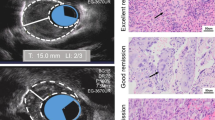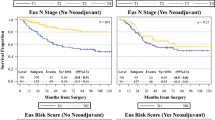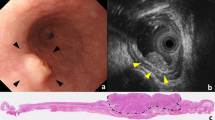Abstract
Background
This study tested the hypothesis that endoluminal ultrasound (EUS) defined total length of disease (including both the primary tumor and the position and number of proximal and distal lymph nodes-ELoD) and the associated EUS lymph node metastasis count (ELNMC) are better predictors of outcome than endoscopic esophageal cancer (OC) length and radiological tumor node metastasis stage in patients who undergo potentially curative treatment with surgery or definitive chemoradiotherapy (dCRT).
Methods
A total of 645 consecutive patients diagnosed with OC and managed by a multidisciplinary team were staged by CT and EUS. The primary outcome measure was survival from date of diagnosis.
Results
A total of 323 patients received surgery (208 neoadjuvant chemotherapy), and 322 who were deemed unsuitable for surgery received dCRT. Univariable analysis revealed that survival was related to EUS T (p < 0.0001), N (p < 0.0001), EUS primary tumor length (p = 0.037), ELoD (p = 0.011), ELNMC (p < 0.0001), and treatment type (p = 0.001). Multivariable analysis revealed two factors: ELoD (hazard ratio (HR), 0.961; 95 % confidence interval (CI), 0.925–0.998; p = 0.041) and ELNMC (HR, 1.08; 95 % CI, 1.015–1.15; p = 0.016) were independently associated with survival.
Conclusions
ELoD and ELNMC should become part of routine OC radiological staging to optimize stage-directed therapeutic outcomes.




Similar content being viewed by others
References
Cancer Research UK. www.cancerresearchuk.org. Accessed 22 Jan 2011
Yendamuri S, Swisher S, Correa A, Hofstetter W, Ajani J, Francis A, Maru D, Mehran R, Rice D, Roth J, Walsh G, Vaporciyan A (2009) Esophageal tumour length is independently associated with long-term survival. Cancer 115:508–516
Eloubeidi MA, Desmond R, Arguedas MR, Reed CE, Wilcox CM (2002) Prognostic factors for the survival of patients with esophageal carcinoma in the U.S.: the importance of tumor length and lymph node status. Cancer 95(7):1434–1443
Bollschweiler E, Baldus S, Schroder W, Schneider P, Holscher A (2006) Staging of esophageal carcinoma: length of tumour and number of involved regional lymph nodes. Are these independent prognostic factors? J Surg Oncol 94:355–363
Griffiths E, Brummell Z, Gorthi G, Pritchard S, Welch I (2006) Tumor length as a prognostic factor in esophageal malignancy: univariate and multivariate survival analyses. J Sur Oncol 93:258–267
Earlam R, Cunha-Melo J (1980) Oesophageal squamous cell carcinoma: I. A critical review of surgery. Br J Surg 67(6):381–390
Ma G, Rong T, Long H, Fu J, Lin P, Huang Z, Zeng C, Zhang X, Li X, Zhang L, Wen Z, Wang J, Zhang P, Hu Y, Zhu Z (2004) Shrinkage of resected specimens of oesophageal carcinoma [abstract]. Ai Zheng 23(2):193–195
Kennedy BJ (1987) The unified international gastric cancer staging classification. Scand J Gastroenterol 22(Suppl 133):11–13
Weaver S, Blackshaw G, Lewis WG, Edwards P, Roberts SA, Thomas GV (2004) Comparison of special interest computerised tomography, endosonography and histopathological stage of oesophageal cancer. Clin Radiol 59:499–504
Kawahara K, Maekawa T, Okabayashi K, Shiraishi T, Yoshinega Y, Yoneda S, Hideshima T, Shirakusa T (1998) The number of lymph node metastases influences survival in esophageal cancer. J Surg Oncol 67:160–163
Sobin LH, Gospodarowicz MK, Wittekind C (2009) UICC TNM classification of malignant tumors, 7th edn. Wiley, New York
Penman I, Norton S, Harris K (2004) Staging of oesophago-gastric carcinoma by endoscopic ultrasonography: guidance and minimum standards. British Society of Gastroenterology [http://www.bsg.org.uk/clinical-guidance/endoscopy/guidance-for-endoscopic-ultrasonography-uk-eus-users-groups-*.html] Accessed 31st March 2011
Medical Research Council Oesophageal Cancer Working Group (2002) Surgical resection with or without preoperative chemotherapy in oesophageal cancer: a randomised controlled trial. Lancet 359:1727–1733
Blazeby JM, Metcalfe C, Nicklin J, Barham CP, Donovan J, Alderson D (2005) Association between quality of life scores and short-term outcome after surgery for cancer of the oesophagus or gastric cardia. Br J Surg 92(12):1502–1578
Crosby TD, Brewster AE, Borley A, Perschky L, Kehagioglou P, Court J, Maughan TS (2005) Definitive chemoradiation in patients with inoperable oesophageal carcinoma. Br J Cancer 90:70–75
Rice PF, Crosby TL, Roberts SA (2003) Variability of the carina-incisor distance as assessed by endoscopic ultrasound. Clin Oncol (R Coll Radiol) 15(7):383–385
Twine CP, Roberts SA, Rawlinson CE, Davies L, Escofet X, Dave BV, Crosby TD, Lewis WG (2010) Prognostic significance of the endoscopic ultrasound defined lymph node metastasis count in esophageal cancer. Dis Esophagus 23(8):652–659
Twine CP, Roberts SA, Lewis WG, Dave BV, Rawlinson CW, Chan D, Robinson M, Crosby TD (2010) Prognostic significance of endoluminal ultrasound-defined disease length and tumor volume (EDTV) for patients with the diagnosis of esophageal cancer. Surg Endosc 24(4):870–878
Korst RJ, Rusch VW, Venkatraman E, Bains MS, Burt ME, Downey RJ (1998) Proposed revision of the staging classification for esophageal cancer. J Thorac Cardiovasc Surg 115(3):660–669
Rizk N, Venkatraman E, Park B, Flores R, Bains MS, Rusch V (2006) The prognostic importance of the number of involved lymph nodes in esophageal cancer: implications for revisions of the American Joint Committee on cancer staging system. J Thorac Cardiovasc Surg 132(6):1374–1381
Gu Y, Swisher SG, Ajani JA, Correa AM, Hofstetter WL, Liao Z (2006) The number of lymph nodes with metastasis predicts survival in patients with esophageal or esophagogastric junction adenocarcinoma who receive preoperative chemoradiation. Cancer 106(5):1017–1025
Mariette C, Piessen G, Briez N, Triboulet JP (2008) The number of metastatic lymph nodes and the ratio between metastatic and examined lymph nodes are independent prognostic factors in esophageal cancer regardless of neoadjuvant chemoradiation or lymphadenectomy extent. Ann Surg 247(2):365–371
Tachibana M, Yoshimura H, Kinugasa S, Dhar DK, Shibakita M, Ohno S (2001) Clinicopathologic factors correlated with number of metastatic lymph nodes in oesophageal cancer. Dig Liver Dis 33(7):534–538
Morgan MA, Lewis WG, Crosby TD, Escofet X, Roberts SA, Brewster AE, Havard TJ, Clark GW (2007) Prospective cohort comparison of neoadjuvant chemoradiotherapy versus chemotherapy in patients with oesophageal cancer. Br J Surg 94(12):1509–1514
Lewis I (1946) The surgical treatment of carcinoma of the oesophagus, with special reference to new operation for growths of middle third. Br J Surg 34:18–31
Tanner IC (1947) The present position of carcinoma of the oesophagus. Postgrad Med J 23:109–139
Orringer MB (1984) Transhiatal oesophagectomy without thoracotomy for carcinoma of the thoracic esophagus. Ann Surg 200:282–288
Kaplan EL, Meier P (1958) Non-parametric estimation from incomplete observations. J Am Stat Assoc 58:457–481
Cox DR (1972) Regression models and life tables. J R Stat Soc B:187–200
Siu KF, Cheung HC, Wong J (1986) Shrinkage of the esophagus after resection for carcinoma. Ann Surg 203(2):173–176
Acknowledgments
This work has been published in part in abstract form: Br J Surg 2010;97(S2):60.
Disclosures
No financial support or commercial backing was received in relation to this work. L. Davies, J.D. Mason, S.A. Roberts, D. Chan, T.D. Reid, M. Robinson, S. Gwynne, T.D. Crosby, and W.G. Lewis have no conflict of interest or financial ties to disclose.
Author information
Authors and Affiliations
Corresponding author
Rights and permissions
About this article
Cite this article
Davies, L., Mason, J.D., Roberts, S.A. et al. Prognostic significance of total disease length in esophageal cancer. Surg Endosc 26, 2810–2816 (2012). https://doi.org/10.1007/s00464-012-2250-3
Received:
Accepted:
Published:
Issue Date:
DOI: https://doi.org/10.1007/s00464-012-2250-3




